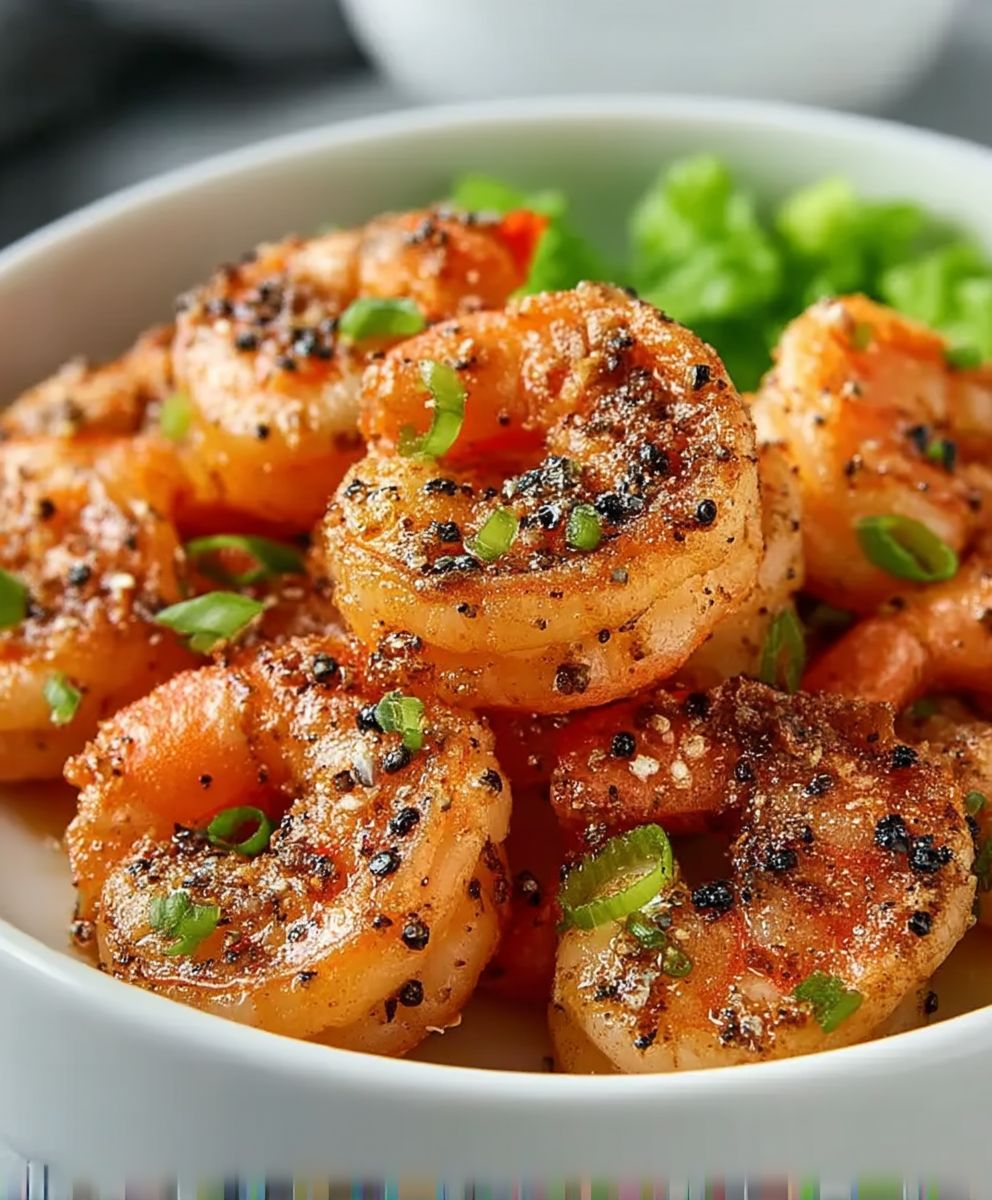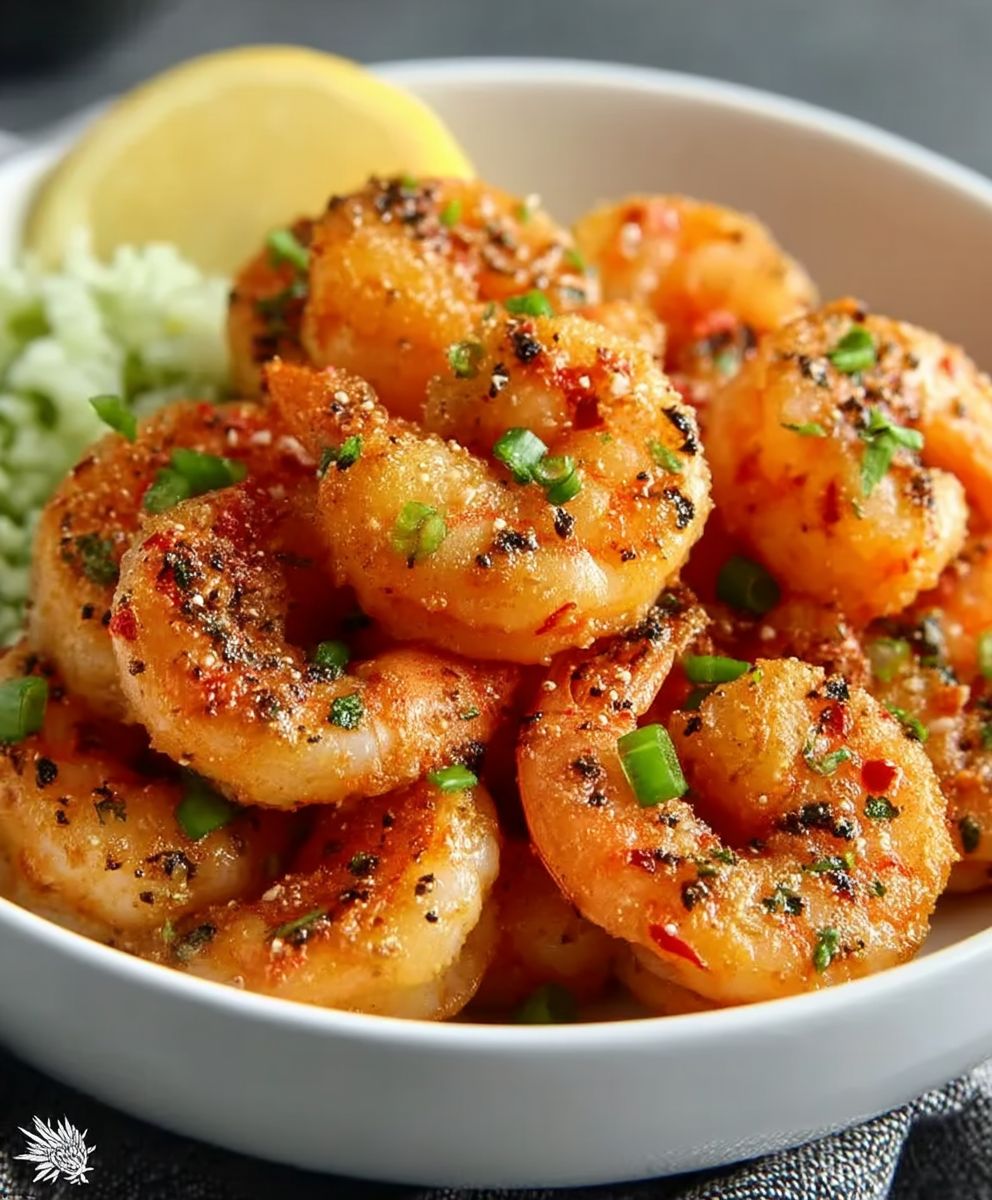Salt Pepper Shrimp: Prepare to embark on a culinary adventure that will tantalize your taste buds and leave you craving more! Imagine succulent shrimp, perfectly crisp and bursting with savory, peppery goodness. This isn’t just a recipe; it’s an experience.
While the exact origins of Salt Pepper Shrimp are debated, many believe it evolved from Cantonese cuisine, where simple yet flavorful dishes are highly prized. The beauty of this dish lies in its minimalist approach a testament to the idea that sometimes, less truly is more. It highlights the natural sweetness of the shrimp, enhanced by the robust flavors of salt and pepper.
What makes this dish so universally loved? It’s the symphony of textures and tastes. The satisfying crunch of the perfectly fried shrimp gives way to a tender, juicy interior. The salt amplifies the shrimp’s natural sweetness, while the pepper adds a delightful kick that keeps you coming back for more. Plus, it’s incredibly quick and easy to prepare, making it a weeknight dinner champion. Whether you’re a seasoned chef or a kitchen novice, this Salt Pepper Shrimp recipe is guaranteed to impress!
Ingredients:
- 1 pound large shrimp, peeled and deveined
- 2 tablespoons olive oil
- 4 cloves garlic, minced
- 1/4 teaspoon red pepper flakes (optional, for heat)
- 1/4 cup dry white wine (such as Sauvignon Blanc or Pinot Grigio)
- 1/4 cup chicken broth
- 2 tablespoons lemon juice, freshly squeezed
- 2 tablespoons butter, unsalted
- 2 tablespoons chopped fresh parsley
- Salt and freshly ground black pepper to taste
- Cooked pasta (linguine, spaghetti, or your favorite), for serving
- Lemon wedges, for garnish (optional)
Preparing the Shrimp:
- Rinse the shrimp: Begin by thoroughly rinsing the shrimp under cold running water. This helps remove any lingering debris or shell fragments. Pat the shrimp dry with paper towels. This is crucial for achieving a good sear later on. Excess moisture will steam the shrimp instead of allowing it to brown properly.
- Season the shrimp: In a medium bowl, toss the shrimp with a generous pinch of salt and freshly ground black pepper. Don’t be shy with the seasoning! The shrimp needs to be well-seasoned to carry the flavor throughout the dish. You can also add a touch of garlic powder or onion powder at this stage if you like.
Cooking the Garlic Shrimp:
- Heat the olive oil: In a large skillet or sauté pan, heat the olive oil over medium-high heat. Make sure the skillet is large enough to accommodate all the shrimp in a single layer. If you overcrowd the pan, the shrimp will steam instead of sear. The oil should shimmer and be hot, but not smoking.
- Sauté the garlic: Add the minced garlic to the hot oil and sauté for about 30 seconds to 1 minute, or until fragrant. Be careful not to burn the garlic, as it will become bitter. Keep it moving in the pan and watch it closely. The aroma of the garlic should fill your kitchen!
- Add the red pepper flakes (optional): If you’re using red pepper flakes for a touch of heat, add them to the skillet along with the garlic. Sauté for a few seconds to release their flavor. Remember, a little goes a long way with red pepper flakes, so start with a small amount and add more to taste.
- Cook the shrimp: Add the seasoned shrimp to the skillet in a single layer. Cook for 2-3 minutes per side, or until the shrimp turn pink and opaque and are cooked through. Avoid overcooking the shrimp, as they will become rubbery. The exact cooking time will depend on the size of your shrimp. Look for a nice pink color and a curled shape.
- Deglaze with white wine: Pour in the dry white wine and let it simmer for about 1 minute, scraping up any browned bits from the bottom of the pan. These browned bits, called fond, are packed with flavor and will add depth to the sauce. The wine will reduce slightly and create a flavorful base for the sauce.
- Add chicken broth and lemon juice: Pour in the chicken broth and lemon juice. Bring the mixture to a simmer and let it cook for another 2-3 minutes, allowing the sauce to reduce slightly and thicken. The lemon juice adds brightness and acidity to balance the richness of the sauce.
- Finish with butter and parsley: Remove the skillet from the heat and stir in the butter until it is melted and the sauce is emulsified. The butter adds richness and a silky texture to the sauce. Stir in the chopped fresh parsley. The parsley adds a fresh, herbaceous note to the dish.
- Season to taste: Taste the sauce and adjust the seasoning with salt and freshly ground black pepper as needed. Remember that the pasta will also absorb some of the salt, so don’t be afraid to season generously.
Serving the Garlic Shrimp:
- Toss with pasta: Add the cooked pasta to the skillet with the garlic shrimp and sauce. Toss to coat the pasta evenly. Make sure every strand of pasta is coated in that delicious sauce!
- Serve immediately: Serve the garlic shrimp and pasta immediately. Garnish with extra chopped parsley and lemon wedges, if desired. A sprinkle of Parmesan cheese is also a great addition.
Tips and Variations:
- Shrimp size: I prefer using large shrimp for this recipe, but you can use any size you like. Just adjust the cooking time accordingly. Smaller shrimp will cook faster, so keep a close eye on them.
- Spice level: Adjust the amount of red pepper flakes to your liking. If you don’t like spice, you can omit them altogether. You can also add a pinch of cayenne pepper for a different kind of heat.
- Wine substitution: If you don’t have white wine on hand, you can substitute it with more chicken broth or vegetable broth. The wine adds a depth of flavor, but the dish will still be delicious without it.
- Creamy sauce: For a creamier sauce, you can add a splash of heavy cream or half-and-half at the end. Stir it in gently and let it warm through before serving.
- Vegetable additions: Feel free to add other vegetables to the skillet along with the garlic. Some good options include cherry tomatoes, spinach, or mushrooms. Sauté the vegetables until they are tender before adding the shrimp.
- Lemon zest: For an extra burst of lemon flavor, add a teaspoon of lemon zest to the sauce along with the lemon juice. Be sure to use a microplane or fine grater to zest the lemon, and avoid grating the white pith, which is bitter.
- Garlic bread: Serve the garlic shrimp with crusty garlic bread for dipping in the sauce. This is a classic combination that is always a crowd-pleaser.
- Herbs: Experiment with different herbs. Basil, oregano, or thyme would all be delicious additions to this dish. Add them along with the parsley at the end.
- Make it ahead: You can prepare the sauce ahead of time and store it in the refrigerator for up to 2 days. When you’re ready to serve, simply reheat the sauce and add the shrimp.
- Serving suggestions: This garlic shrimp is also delicious served over rice, quinoa, or polenta. You can also serve it as an appetizer with crusty bread for dipping.
Detailed Explanation of Key Steps:
Why Patting the Shrimp Dry is Important:
I cannot stress enough how important it is to pat the shrimp dry before cooking. This step is often overlooked, but it makes a huge difference in the final result. When shrimp are wet, they will steam in the pan instead of searing. Searing is what gives the shrimp that beautiful golden-brown color and delicious flavor. Patting the shrimp dry removes excess moisture and allows them to brown properly.
The Art of Sautéing Garlic:
Sautéing garlic is a delicate art. You want to cook it until it is fragrant and slightly golden, but you don’t want to burn it. Burnt garlic is bitter and will ruin the flavor of the dish. The key is to keep the heat at medium-high and to stir the garlic constantly. Watch it closely and remove it from the heat as soon as it starts to turn golden.
Deglazing the Pan for Maximum Flavor:
Deglazing the pan with white wine is a crucial step in creating a flavorful sauce. As the shrimp and garlic cook, they leave behind browned bits on the bottom of the pan. These browned bits, called fond, are packed with flavor. When you add the white wine, it loosens these browned bits and incorporates them into the sauce. This adds depth and complexity to the flavor of the dish.
The Importance of Fresh Lemon Juice:
Fresh lemon juice is essential for this recipe. Bottled lemon juice simply doesn’t have the same bright, fresh flavor. The lemon juice adds acidity to the sauce, which balances the richness of the butter and shrimp. It also brightens up the flavors and adds a touch of zing.
Emulsifying the Butter for a Silky Sauce:
Emulsifying the butter into the sauce is what gives it that silky, luxurious texture. To emulsify the butter, remove the skillet from the heat and stir in the butter until it is completely melted and incorporated into the sauce. The sauce should become smooth and creamy. This step is what elevates the dish from good to great.
Choosing the Right Pasta:
While I recommend linguine or spaghetti for this recipe, you can really use any type of pasta you like. The key is to choose a pasta that will hold the sauce well. Long, thin strands of pasta like linguine and spaghetti are ideal because they have a large surface area that allows

Conclusion:
So, there you have it! This Salt Pepper Shrimp recipe is truly a must-try for anyone who loves bold flavors and quick, easy meals. The crispy shrimp, the aromatic spices, and the satisfying crunch it all comes together to create a dish that’s both incredibly delicious and surprisingly simple to make. I know I keep saying it, but seriously, the flavor explosion you get from such minimal effort is just astounding.
Why is it a must-try? Well, beyond the incredible taste, it’s incredibly versatile. It’s perfect as a quick weeknight dinner, a crowd-pleasing appetizer for your next gathering, or even a flavorful addition to your lunch bowl. Plus, it’s naturally gluten-free, making it a great option for those with dietary restrictions. I’ve made this recipe countless times, and it’s always a hit.
Serving Suggestions and Variations:
Now, let’s talk about how you can serve this amazing Salt Pepper Shrimp. My personal favorite is to serve it over a bed of fluffy white rice, allowing the flavorful sauce to soak in. A side of steamed broccoli or stir-fried vegetables complements the dish perfectly. You could also try serving it with noodles, like lo mein or udon, for a heartier meal.
For a fun appetizer, arrange the shrimp on a platter with lemon wedges and a side of sweet chili sauce for dipping. Trust me, your guests will devour them!
And if you’re feeling adventurous, there are plenty of variations you can try. Add a pinch of red pepper flakes for extra heat, or a squeeze of lime juice for a tangy twist. You could even experiment with different spices, like garlic powder, onion powder, or smoked paprika. I’ve even tried adding a touch of honey for a sweet and savory flavor profile it was surprisingly delicious!
Another fantastic variation is to use different types of seafood. While shrimp is my go-to, you could easily substitute it with calamari, scallops, or even chunks of firm white fish. Just adjust the cooking time accordingly to ensure the seafood is cooked through but still tender.
Don’t be afraid to get creative and experiment with different flavors and ingredients to make this recipe your own! That’s the beauty of cooking, after all.
I truly believe that this Salt Pepper Shrimp recipe will become a staple in your kitchen. It’s quick, easy, and incredibly satisfying. It’s the kind of dish that you can whip up on a busy weeknight or impress your friends with at a dinner party.
So, what are you waiting for? Grab your ingredients, fire up your wok (or skillet!), and get ready to experience the deliciousness of this amazing dish. I’m confident that you’ll love it as much as I do.
And most importantly, I want to hear about your experience! Did you try the recipe? Did you make any variations? What did you think? Share your thoughts, photos, and tips in the comments below. I’m always excited to see how others put their own spin on my recipes. Happy cooking! I can’t wait to hear from you!
Salt Pepper Shrimp: The Ultimate Recipe and Cooking Guide
Quick and easy garlic shrimp pasta, bursting with flavor from garlic, white wine, lemon, and fresh parsley. A perfect weeknight meal!
Ingredients
- 1 pound large shrimp, peeled and deveined
- 2 tablespoons olive oil
- 4 cloves garlic, minced
- 1/4 teaspoon red pepper flakes (optional, for heat)
- 1/4 cup dry white wine (such as Sauvignon Blanc or Pinot Grigio)
- 1/4 cup chicken broth
- 2 tablespoons lemon juice, freshly squeezed
- 2 tablespoons butter, unsalted
- 2 tablespoons chopped fresh parsley
- Salt and freshly ground black pepper to taste
- Cooked pasta (linguine, spaghetti, or your favorite), for serving
- Lemon wedges, for garnish (optional)
Instructions
- Rinse the shrimp under cold running water and pat dry with paper towels. In a medium bowl, toss the shrimp with salt and pepper.
- In a large skillet or sauté pan, heat the olive oil over medium-high heat. Add the minced garlic and sauté for 30 seconds to 1 minute, until fragrant. Add red pepper flakes (if using) and sauté for a few seconds.
- Add the seasoned shrimp to the skillet in a single layer. Cook for 2-3 minutes per side, until pink and opaque.
- Pour in the white wine and let it simmer for about 1 minute, scraping up any browned bits from the bottom of the pan.
- Pour in the chicken broth and lemon juice. Bring to a simmer and cook for 2-3 minutes, allowing the sauce to reduce slightly.
- Remove from heat and stir in the butter until melted and the sauce is emulsified. Stir in the fresh parsley.
- Taste and adjust seasoning with salt and pepper as needed.
- Add the cooked pasta to the skillet with the garlic shrimp and sauce. Toss to coat.
- Serve immediately, garnished with extra parsley and lemon wedges (optional).
Notes
- Shrimp Size: Use any size shrimp, adjusting cooking time accordingly.
- Spice Level: Adjust red pepper flakes to your preference.
- Wine Substitution: Use more chicken broth if you don’t have white wine.
- Creamy Sauce: Add a splash of heavy cream at the end for a creamier sauce.
- Vegetable Additions: Add cherry tomatoes, spinach, or mushrooms to the skillet with the garlic.
- Lemon Zest: Add a teaspoon of lemon zest for extra lemon flavor.
- Garlic Bread: Serve with crusty garlic bread for dipping.
- Herbs: Experiment with basil, oregano, or thyme.
- Make Ahead: Prepare the sauce ahead of time and store in the refrigerator for up to 2 days.
- Serving Suggestions: Serve over rice, quinoa, or polenta, or as an appetizer with crusty bread.
- Patting the Shrimp Dry: Patting the shrimp dry before cooking is crucial for achieving a good sear.
- Sautéing Garlic: Watch the garlic closely and remove it from the heat as soon as it starts to turn golden.
- Deglazing the Pan: Deglazing the pan with white wine is a crucial step in creating a flavorful sauce.
- Fresh Lemon Juice: Fresh lemon juice is essential for this recipe.
- Emulsifying the Butter: Emulsifying the butter into the sauce is what gives it that silky, luxurious texture.

